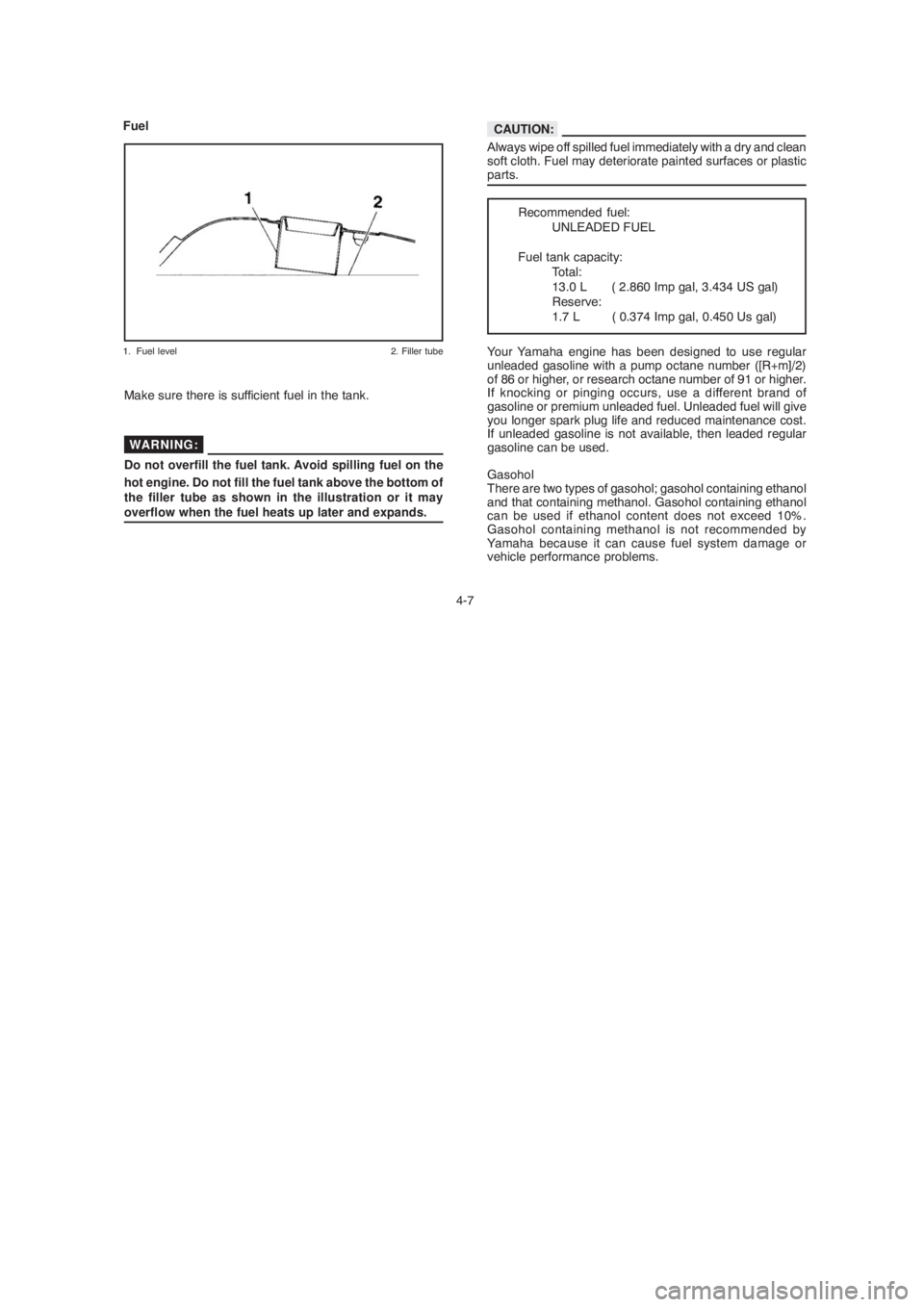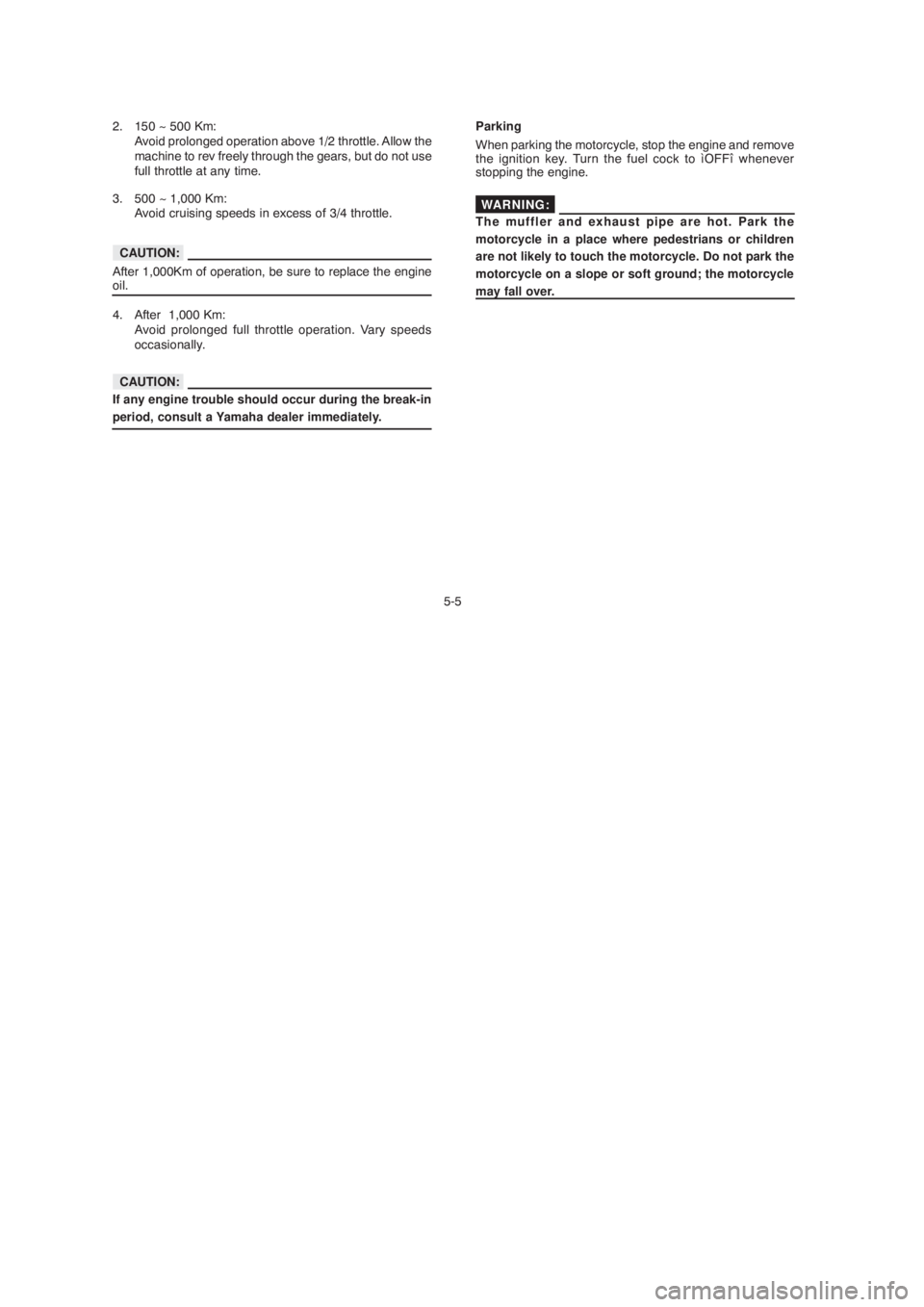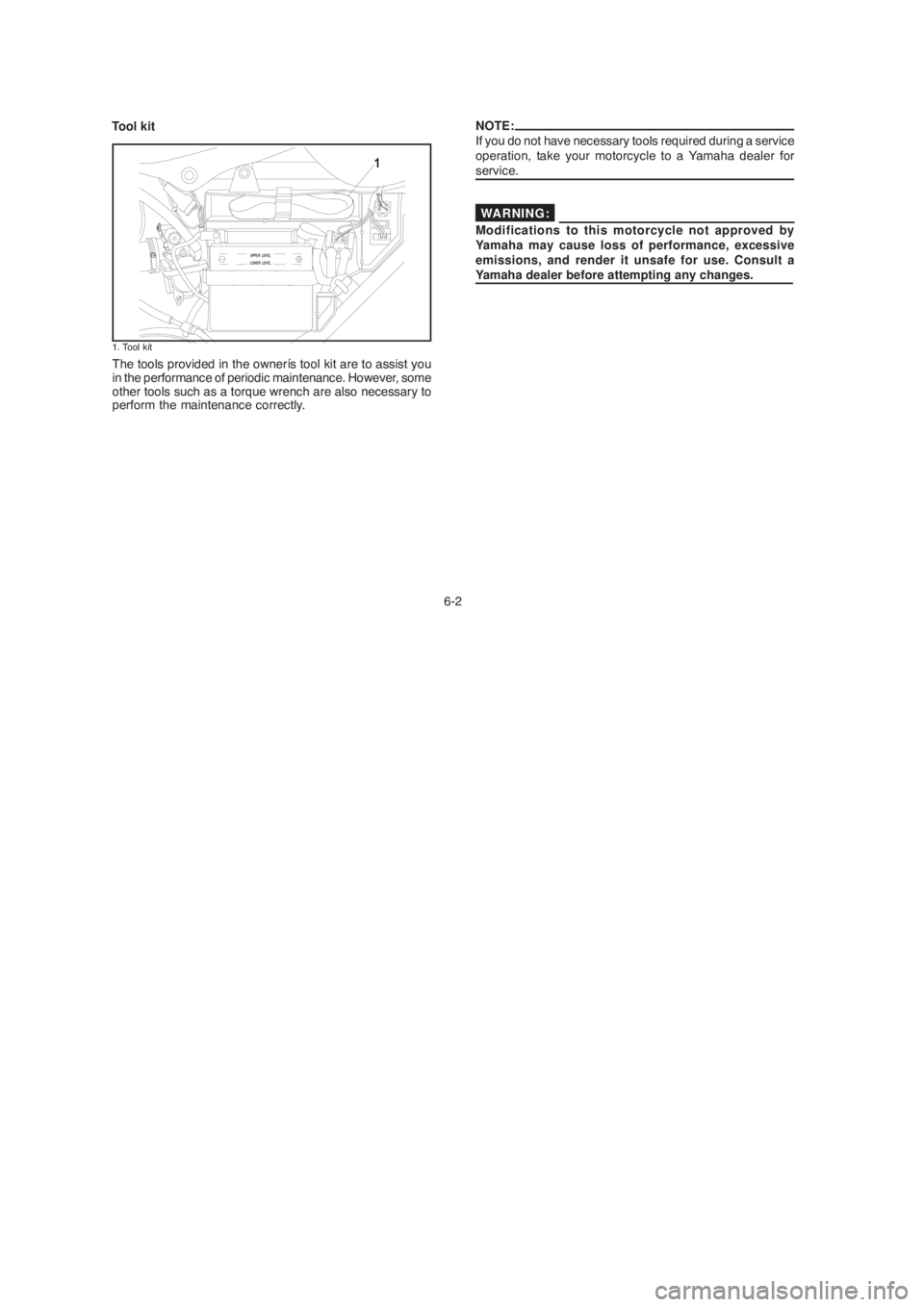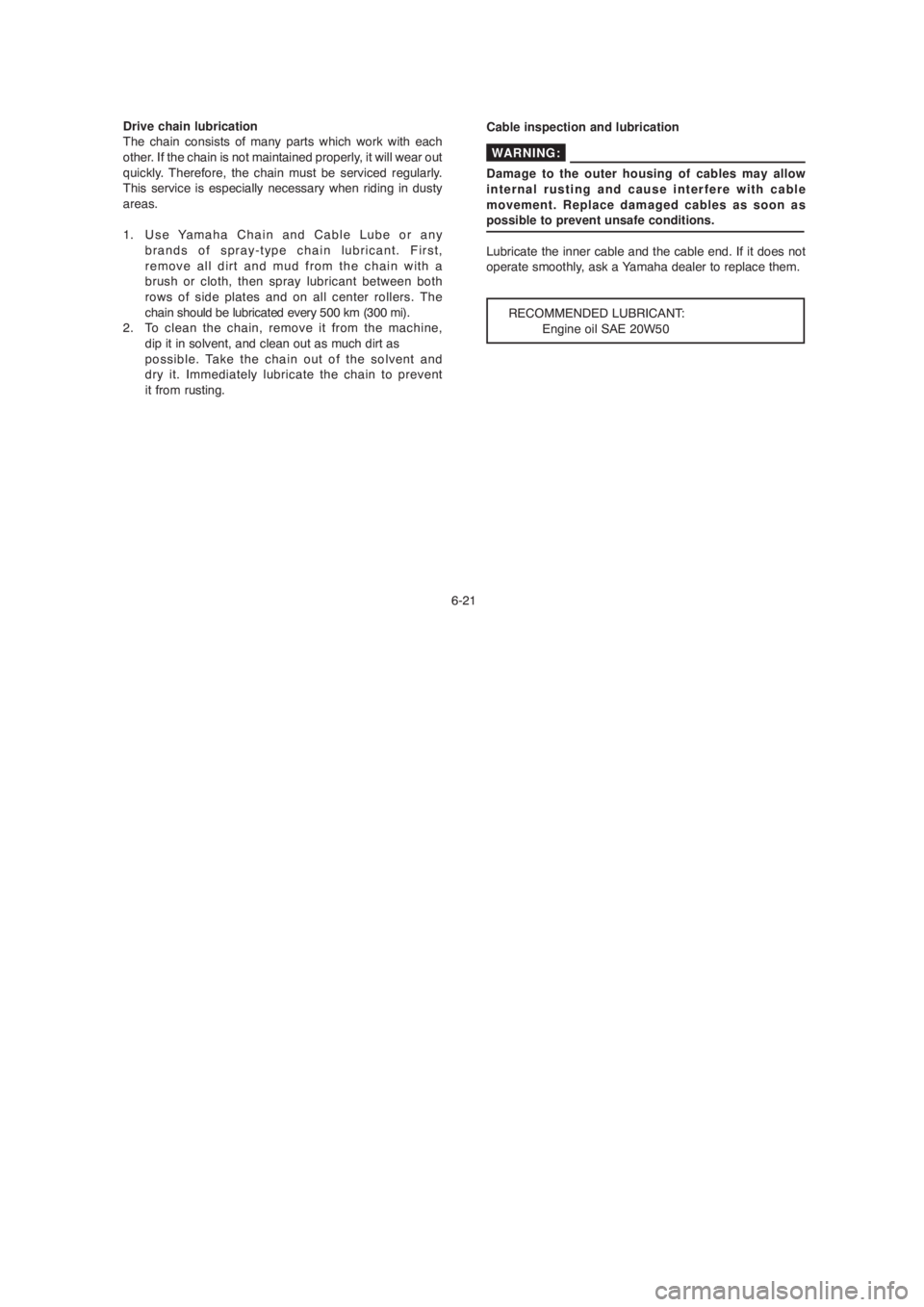2004 YAMAHA YBR125 warning
[x] Cancel search: warningPage 33 of 83

4-5 2. Tire inspection
Always check the tires before operating the motorcycle.
If a tire tread shows crosswise lines (minimum tread
depth), if the tire has a nail or glass fragments in it, or
if the side wall is cracked, contact a Yamaha dealer or
other qualified mechanic and have the tire replaced.
1. Tread depth 2. Side wall 3. wear indicator
After extensive tests, the tires listed below have been
approved by Yamaha for this model. The front and rear
tires should always be by the same manufacturer and
of the same design. No guarantee concerning handling
characteristics can be given if a tire combination other
than one approved by Yamaha is used on this
motorcycle.
Front
Rear
Size Manufacturer
Type
Minimum tire tread depth
(from and rear)0,8 mm (0,032 in) 2.75-18 PIRELLI
42P MT 39
90/90-18 PIRELLI
57P MT 15
WARNING:
4-5 2. Tire inspection
Always check the tires before operating the motorcycle.
If a tire tread shows crosswise lines (minimum tread
depth), if the tire has a nail or glass fragments in it, or
if the side wall is cracked, contact a Yamaha dealer or
other qualified mechanic and have the tire replaced.
1. Tread depth 2. Side wall 3. wear indicator
After extensive tests, the tires listed below have been
approved by Yamaha for this model. The front and rear
tires should always be by the same manufacturer and
of the same design. No guarantee concerning handling
characteristics can be given if a tire combination other
than one approved by Yamaha is used on this
motorcycle.
Front
Rear
Size Manufacturer
Type
Minimum tire tread depth
(from and rear)0,8 mm (0,032 in) 2.75-18 PIRELLI
42P MT 39
90/90-18 PIRELLI
57P MT 15
WARNING:
Page 34 of 83

4-6
1. It is dangerous to ride with a worn-out tire. When
the tire tread begin to show signs of wear, replace
the tire immediately. Brakes, tires and related wheel
parts should be left to a Yamaha dealer.
2. Patching a punctured tube is not recommended. If
it is absolutely necessary to do so, use great care
and replace the tube as soon as possible with a
good quality replacement.
Fitting/Fasteners
Alway check the tightness of chassis fittings and fasteners
before a ride. Use the chart on page 6-5 to find the correct
torque.
Switches
Check the operation of the starter switch, main switch,
ì Engine Stopî switch.
WARNING:Wheels
To ensure maximum performance, long service, and safe
operation, note the following:
1. Always inspect the wheels before a ride. Check for
cracks, bends, or warpage of the wheel; be sure the
spokes are tight and undamaged. If any abnormal
condition exists in a wheel, consult a Yamaha dealer or
other qualified mechanic. Do not attempt even small
repairs to the wheel. If a wheel is deformed or cracked,
it must be replaced.
2. Tires and wheels should be balanced whenever either
one is changed or replaced. Failure to have a wheel
balanced can result in poor performance, adverse
handling characteristics, and shortened tire life.
3. After installing a tire, ride conservatively to allow the
tire to seat itself on the rim properly. Failure to allow
proper seating may cause tire failure, resulting in
damage to the motorcycle and injury to the rider.
4-6
1. It is dangerous to ride with a worn-out tire. When
the tire tread begin to show signs of wear, replace
the tire immediately. Brakes, tires and related wheel
parts should be left to a Yamaha dealer.
2. Patching a punctured tube is not recommended. If
it is absolutely necessary to do so, use great care
and replace the tube as soon as possible with a
good quality replacement.
Fitting/Fasteners
Alway check the tightness of chassis fittings and fasteners
before a ride. Use the chart on page 6-5 to find the correct
torque.
Switches
Check the operation of the starter switch, main switch,
ì Engine Stopî switch.
WARNING:Wheels
To ensure maximum performance, long service, and safe
operation, note the following:
1. Always inspect the wheels before a ride. Check for
cracks, bends, or warpage of the wheel; be sure the
spokes are tight and undamaged. If any abnormal
condition exists in a wheel, consult a Yamaha dealer or
other qualified mechanic. Do not attempt even small
repairs to the wheel. If a wheel is deformed or cracked,
it must be replaced.
2. Tires and wheels should be balanced whenever either
one is changed or replaced. Failure to have a wheel
balanced can result in poor performance, adverse
handling characteristics, and shortened tire life.
3. After installing a tire, ride conservatively to allow the
tire to seat itself on the rim properly. Failure to allow
proper seating may cause tire failure, resulting in
damage to the motorcycle and injury to the rider.
Page 35 of 83

4-7Always wipe off spilled fuel immediately with a dry and clean
soft cloth. Fuel may deteriorate painted surfaces or plastic
parts. Fuel
1. Fuel level 2. Filler tube
Make sure there is sufficient fuel in the tank.
Do not overfill the fuel tank. Avoid spilling fuel on the
hot engine. Do not fill the fuel tank above the bottom of
the filler tube as shown in the illustration or it may
overflow when the fuel heats up later and expands.
Recommended fuel:
UNLEADED FUEL
Fuel tank capacity:
Total:
13.0 L ( 2.860 Imp gal, 3.434 US gal)
Reserve:
1.7 L ( 0.374 Imp gal, 0.450 Us gal)
WARNING:
CAUTION:
Your Yamaha engine has been designed to use regular
unleaded gasoline with a pump octane number ([R+m]/2)
of 86 or higher, or research octane number of 91 or higher.
If knocking or pinging occurs, use a different brand of
gasoline or premium unleaded fuel. Unleaded fuel will give
you longer spark plug life and reduced maintenance cost.
If unleaded gasoline is not available, then leaded regular
gasoline can be used.
Gasohol
There are two types of gasohol; gasohol containing ethanol
and that containing methanol. Gasohol containing ethanol
can be used if ethanol content does not exceed 10%.
Gasohol containing methanol is not recommended by
Yamaha because it can cause fuel system damage or
vehicle performance problems.
4-7Always wipe off spilled fuel immediately with a dry and clean
soft cloth. Fuel may deteriorate painted surfaces or plastic
parts. Fuel
1. Fuel level 2. Filler tube
Make sure there is sufficient fuel in the tank.
Do not overfill the fuel tank. Avoid spilling fuel on the
hot engine. Do not fill the fuel tank above the bottom of
the filler tube as shown in the illustration or it may
overflow when the fuel heats up later and expands.
Recommended fuel:
UNLEADED FUEL
Fuel tank capacity:
Total:
13.0 L ( 2.860 Imp gal, 3.434 US gal)
Reserve:
1.7 L ( 0.374 Imp gal, 0.450 Us gal)
WARNING:
CAUTION:
Your Yamaha engine has been designed to use regular
unleaded gasoline with a pump octane number ([R+m]/2)
of 86 or higher, or research octane number of 91 or higher.
If knocking or pinging occurs, use a different brand of
gasoline or premium unleaded fuel. Unleaded fuel will give
you longer spark plug life and reduced maintenance cost.
If unleaded gasoline is not available, then leaded regular
gasoline can be used.
Gasohol
There are two types of gasohol; gasohol containing ethanol
and that containing methanol. Gasohol containing ethanol
can be used if ethanol content does not exceed 10%.
Gasohol containing methanol is not recommended by
Yamaha because it can cause fuel system damage or
vehicle performance problems.
Page 40 of 83

5-5 2. 150 ~ 500 Km:
Avoid prolonged operation above 1/2 throttle. Allow the
machine to rev freely through the gears, but do not use
full throttle at any time.
3. 500 ~ 1,000 Km:
Avoid cruising speeds in excess of 3/4 throttle.
After 1,000Km of operation, be sure to replace the engine
oil.
4. After 1,000 Km:
Avoid prolonged full throttle operation. Vary speeds
occasionally.
If any engine trouble should occur during the break-in
period, consult a Yamaha dealer immediately.Parking
When parking the motorcycle, stop the engine and remove
the ignition key. Turn the fuel cock to ìOFFî whenever
stopping the engine.
The muffler and exhaust pipe are hot. Park the
motorcycle in a place where pedestrians or children
are not likely to touch the motorcycle. Do not park the
motorcycle on a slope or soft ground; the motorcycle
may fall over.
CAUTION:
CAUTION:
WARNING:
5-5 2. 150 ~ 500 Km:
Avoid prolonged operation above 1/2 throttle. Allow the
machine to rev freely through the gears, but do not use
full throttle at any time.
3. 500 ~ 1,000 Km:
Avoid cruising speeds in excess of 3/4 throttle.
After 1,000Km of operation, be sure to replace the engine
oil.
4. After 1,000 Km:
Avoid prolonged full throttle operation. Vary speeds
occasionally.
If any engine trouble should occur during the break-in
period, consult a Yamaha dealer immediately.Parking
When parking the motorcycle, stop the engine and remove
the ignition key. Turn the fuel cock to ìOFFî whenever
stopping the engine.
The muffler and exhaust pipe are hot. Park the
motorcycle in a place where pedestrians or children
are not likely to touch the motorcycle. Do not park the
motorcycle on a slope or soft ground; the motorcycle
may fall over.
CAUTION:
CAUTION:
WARNING:
Page 42 of 83

NOTE:
If you do not have necessary tools required during a service
operation, take your motorcycle to a Yamaha dealer for
service.
Modifications to this motorcycle not approved by
Yamaha may cause loss of performance, excessive
emissions, and render it unsafe for use. Consult a
Yamaha dealer before attempting any changes.
6-2 Tool kit
The tools provided in the ownerís tool kit are to assist you
in the performance of periodic maintenance. However, some
other tools such as a torque wrench are also necessary to
perform the maintenance correctly.
1. Tool kit
WARNING:
NOTE:
If you do not have necessary tools required during a service
operation, take your motorcycle to a Yamaha dealer for
service.
Modifications to this motorcycle not approved by
Yamaha may cause loss of performance, excessive
emissions, and render it unsafe for use. Consult a
Yamaha dealer before attempting any changes.
6-2 Tool kit
The tools provided in the ownerís tool kit are to assist you
in the performance of periodic maintenance. However, some
other tools such as a torque wrench are also necessary to
perform the maintenance correctly.
1. Tool kit
WARNING:
Page 61 of 83

6-21 Drive chain lubrication
The chain consists of many parts which work with each
other. If the chain is not maintained properly, it will wear out
quickly. Therefore, the chain must be serviced regularly.
This service is especially necessary when riding in dusty
areas.
1. Use Yamaha Chain and Cable Lube or any
brands of spray-type chain lubricant. First,
remove all dirt and mud from the chain with a
brush or cloth, then spray lubricant between both
rows of side plates and on all center rollers. The
chain should be lubricated every 500 km (300 mi).
2. To clean the chain, remove it from the machine,
dip it in solvent, and clean out as much dirt as
possible. Take the chain out of the solvent and
dry it. Immediately lubricate the chain to prevent
it from rusting.Cable inspection and lubrication
Damage to the outer housing of cables may allow
internal rusting and cause interfere with cable
movement. Replace damaged cables as soon as
possible to prevent unsafe conditions.
Lubricate the inner cable and the cable end. If it does not
operate smoothly, ask a Yamaha dealer to replace them.
RECOMMENDED LUBRICANT:
Engine oil SAE 20W50
WARNING:
6-21 Drive chain lubrication
The chain consists of many parts which work with each
other. If the chain is not maintained properly, it will wear out
quickly. Therefore, the chain must be serviced regularly.
This service is especially necessary when riding in dusty
areas.
1. Use Yamaha Chain and Cable Lube or any
brands of spray-type chain lubricant. First,
remove all dirt and mud from the chain with a
brush or cloth, then spray lubricant between both
rows of side plates and on all center rollers. The
chain should be lubricated every 500 km (300 mi).
2. To clean the chain, remove it from the machine,
dip it in solvent, and clean out as much dirt as
possible. Take the chain out of the solvent and
dry it. Immediately lubricate the chain to prevent
it from rusting.Cable inspection and lubrication
Damage to the outer housing of cables may allow
internal rusting and cause interfere with cable
movement. Replace damaged cables as soon as
possible to prevent unsafe conditions.
Lubricate the inner cable and the cable end. If it does not
operate smoothly, ask a Yamaha dealer to replace them.
RECOMMENDED LUBRICANT:
Engine oil SAE 20W50
WARNING:
Page 62 of 83

6-22
Throttle cable and grip lubrication
The throttle twist grip assembly should be greased at the
time the cable is lubricated, since the grip must be removed
to get at the end of the throttle cable.
After removing the screws, hold the end of the cable up in
the air and put in several drops of lubricant. With the throttle
grip disassembled, coat the metal surface of the grip
assembly with a suitable all-purpose grease.Brake and shift pedals
Lubricate the pivoting parts.
RECOMMENDED LUBRICANT:
Engine oil SAE 20W50
Brake and clutch levers
Lubricate the pivoting parts.
RECOMMENDED LUBRICANT:
Engine oil SAE 20W50
Sidestand
Lubricate the pivoting parts. Check to see that the sidestand
moves up and down smoothly.
RECOMMENDED LUBRICANT:
Engine oil SAE 20W50
WARNING:
If the sidestand does not move smoothly, consult a
Yamaha dealer.
CAUTION:
6-22
Throttle cable and grip lubrication
The throttle twist grip assembly should be greased at the
time the cable is lubricated, since the grip must be removed
to get at the end of the throttle cable.
After removing the screws, hold the end of the cable up in
the air and put in several drops of lubricant. With the throttle
grip disassembled, coat the metal surface of the grip
assembly with a suitable all-purpose grease.Brake and shift pedals
Lubricate the pivoting parts.
RECOMMENDED LUBRICANT:
Engine oil SAE 20W50
Brake and clutch levers
Lubricate the pivoting parts.
RECOMMENDED LUBRICANT:
Engine oil SAE 20W50
Sidestand
Lubricate the pivoting parts. Check to see that the sidestand
moves up and down smoothly.
RECOMMENDED LUBRICANT:
Engine oil SAE 20W50
WARNING:
If the sidestand does not move smoothly, consult a
Yamaha dealer.
CAUTION:
Page 63 of 83

6-23
1. Visual check
Check for scratches or damage on the inner tube and
excessive oil leakage from the front fork.
2. Operation check
Place the motorcycle on a level place.
a. Hold the motorcycle in an upright position and apply
the front brake.
b. Push down hard several times and check if the fork
rebounds smoothly.
If any damage or unsmooth movement is found with
the front fork, consult a Yamaha dealer. Front fork inspection
Securely support the motorcycle so there is no danger
of it falling over.
CAUTION:
WARNING:
6-23
1. Visual check
Check for scratches or damage on the inner tube and
excessive oil leakage from the front fork.
2. Operation check
Place the motorcycle on a level place.
a. Hold the motorcycle in an upright position and apply
the front brake.
b. Push down hard several times and check if the fork
rebounds smoothly.
If any damage or unsmooth movement is found with
the front fork, consult a Yamaha dealer. Front fork inspection
Securely support the motorcycle so there is no danger
of it falling over.
CAUTION:
WARNING: